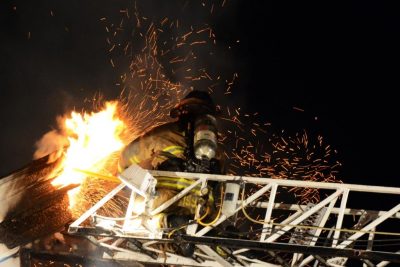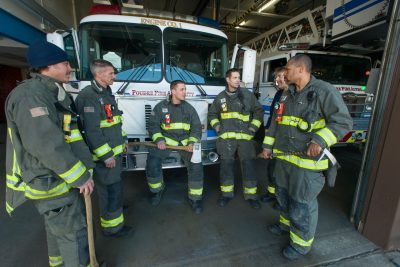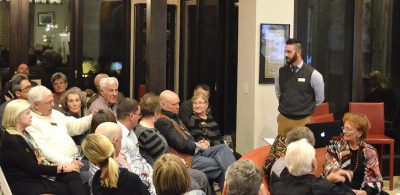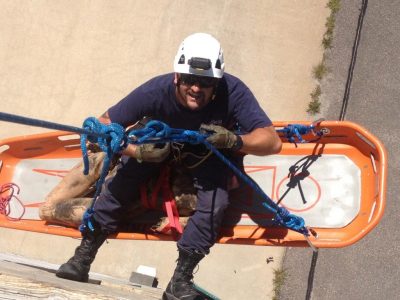Timothy Amidon, an assistant professor in the Department of English at Colorado State University, spent his summer (and much of his academic career!) researching the role of firefighter communication in preventing disasters and tragedies.
Tim has more than 15 years of experience in the fire service as a firefighter and officer with Westerly Fire Department in Rhode Island, a fire instructor with the Rhode Island Fire Academy, and a technician with Rhode Island Search and Rescue. He has devoted his academic research to understanding and improving firefighter communication.
According to Tim, about 100 firefighters die each year in the line of duty, and many more are seriously injured. Structural and equipment issues can play a role in these casualties, but communication problems are a factor that is often overlooked or misunderstood. If a firefighter is unable to correctly interpret fire behavior and communicate important information back to the rest of the team, for instance, the situation can quickly escalate to danger. Firefighters must learn how to use aural and radio literacy to rapidly process and prioritize communications in a high-stress environment.
Read the following interview with Tim, and check out this story from Source to learn more about his research!
What inspired you to get involved in firefighting?
Well, my dad likes to say I became a firefighter because he read Margaret Wise Brown’s The Little Fireman to me too many times. But, growing up around a lot of folks in the service (my dad was in the Navy) probably had something to do with it. The exact reason is that when I was growing up, my best friends were a set of twins, and their dad, Steve (who was in the Coast Guard) was a volunteer in Westerly Fire Department in Westerly, Rhode Island. Growing up, Steve would occasionally bring us to the station where we’d play pool, wash dishes, and help the firefighters clean up after meetings. Sometimes he’d let us ride along in his truck to the alarms too, and we could sit in the truck and watch firefighters work. But, that ended up being pretty boring, mostly, because a lot of the alarms I remember going to as a teenager were false.
Anyways, when I was in high school a couple of the older guys that I surfed with and looked up to were lifeguards, so I started training to become a lifeguard so I could work at the beach with them when I turned 16. That first summer, I had a lot of opportunities to help people and I realized that being a first responder was something that I enjoyed: the first day I worked on the beach, for what it’s worth, a patron had a cardiac event, so I got indoctrinated into the reality of responding pretty quickly.
After two summers, I was 18, a senior in high school, and I wanted to help in other ways, too, so I asked Steve to sponsor me to join the fire department. I filled out an application, had a physical and a background check, went to an interview with leaders of the department, and, after being approved and taking an oath, they gave me a helmet, a set of gear, and a pager and said show up when that goes off. So, I did for 16 years, until I moved out here. While I was showing up over that period of time, I got super involved. I went to a lot of fire academy classes and earned a lot of certifications: tech-rescue disciplines like swift water, rope, and heavy rescue to rapid intervention and organizational certifications like fire officer, safety officer, fire instructor. After some time, I became a lieutenant, then, a captain for one of the engine companies in the department. Also, I began teaching firefighting at the RI State Fire Academy, the Union Fire District, as well as with the Tiverton Fire Department recruit academies. And, I joined RI Urban Search and Rescue and served with them for a couple of years.

Did you have a particular experience that piqued your interest in the communication between firefighters?
Yes. Lots of experiences with communication, but really a big part of it for me is that communication is how firefighters understand that term. To me it’s literacy. I’m really, ultimately, a literacy researcher. And, as a digital rhetorician/computer and composition scholar, I understand literacy as a thing that has both multimodal and multimedia dimensions.
In graduate school, I read Beverly Sauer’s The Rhetoric of Risk, which is a study of the ways official discourse regarding risk in mining communities differs from the embodied literacies and practices that miners use to construct and communicate risk. As I read the body of research on rhetoric and risk communication, I came to understand that there really isn’t much other work that looks at the ways how other types of blue-collar workers, like firefighters, use embodied literacies–tactile, kinesthetic, aural, visual, gestural literacies–to construct and communicate knowledge in risk environments. That’s when I said, whoa, ok, I see that there is a huge gap in research here. We don’t know much about the ways that blue-collar workers like miners do literacy in workplace settings. Most workplace writing (literacy) studies are of engineers or software developers and things like that. And, so, I was like, hey, I think this subjectivity where I’m a rhetoric and literacy scholar and a firefighter might be related. Up to that point, I kind of just did those different things and didn’t see them as super related, so it was really Sauer’s work that pushed me to start pushing this connection as a researcher.
To answer your question, yeah, I do have first-hand experiences that relate to the time I spent serving my community that influence how I think about some of these things. Right now, I’m really interested in how firefighters learn the many tacit forms of literacy they use to construct knowledge in risk settings, and how we might teach those in more transparent/less tacit ways so that firefighters have access to the forms of literacy and knowledge-making practices that would help them work more safely when they are in risk environments. Things like reading smoke, for instance, is something that is difficult to teach, but it happens. I want to learn more about how those types of literacies are acquired by new members of this discourse community.
What does your research with firefighter communication involve?
I’m working on a couple of projects related to fire fighting, but not actual wildland fire communications presently. One project is with a researcher and former wildland firefighter, Mike Caggiano, who knows a great deal about the Wildland Urban Interface (WUI). I’ve been working with Mike on a project that was funded by the the Colorado Forest Restoration Institute. In that project, we’re trying to better understand if/how different homeowners, firefighters, and forest mitigation specialists understand/construct defensible space as a similar concept. Our preliminary data suggests that they are some pretty significant differences regarding the ways that defensible space is understood, rhetorically, by the stakeholders. For instance, we are seeing different definitions about what it is. Especially, regarding the aims of what it does, how it works, and if it is effective under various conditions (e.g., if firefighters respond; if it is a crown fire). Right now, we’re finishing up some of the coding and analysis of that project, and we’re hoping to finish writing the paper and submit it to a journal by December.
There are three projects that deal more with communication at the firefighter/fireground level that I’m working on right now, too. I have been working on a foundational article that sets out the preliminary methodological argument for why combining methods like (genre ecology modeling) from writing activity and genre research (WAGR) with multimodal and sensory ethnography (Sarah Pink’s work, also Brian McNely over at University at Kentucky) are useful for studying the types of literacies I’m interested in better understanding. I’m trying to get this one out by this fall.
I’m working on a different methodological project related to challenges of enacting participatory community based research in communities where you’re perceived as an insider with W. Michele Simmons. We’ll be presenting on this at SIGDOC in Washington, D.C. in September, and we’ll have a peer-reviewed paper on this in the upcoming SIGDOC Proceedings. We plan to start a larger study that expands on this preliminary work.
And, I’m working with an interdisciplinary PRECIP team (Elizabeth Williams, Kim Henry, and Tiffany Lipsey) and leaders from the training division of Poudre Fire Authority to refine and develop research methods that will enable us to better understand how ‘communications’ connect to safety in fireground practices. So, we’re really looking, primarily at structure fire settings, but I’d suspect that what we learn will have relevance for wildland firefighting, too.

Have you ever witnessed a disaster that possibly could have been prevented by better communication between firefighters?
The communications failures associated with 9/11 and the Challenger explosion are very well documented in research. And, personally, yes, I’ve been on scenes were things went poorly due to poor “communications.” Communicating in risk environments is highly challenging for a number of reasons. One is that first responders are working in time sensitive contexts. Folks make decisions in seconds that have huge consequences for the emergency and the responders alike. It’s important to understand that, but I think as a researcher you have to really, really be cognizant of that to avoid coming off as a “Monday morning quarterback.” Folks make tough decisions–that often impact whether they and others will live– with little time to do so. That’s consequential.
Another is that the environments themselves impact the how responders make sense of information and communicate that information. There are issues of power, credibility, and trust that impact how decisions are made, but also the fact that firefighters often can’t hear, see, or talk well because they are working in gear and places that are loud or dark or where there is zero visibility. So, when I say, yes I’ve seen communications breakdowns or situations where these contributed to ‘disaster’, I mean it in the sense that literacy is a two way kind of thing. It’s about reading and writing. I’ve been in situations, personally as a firefighter and rescuer, where I didn’t have access to the types of literacies that would have enabled me to make effective decisions to mitigate my own risk as a worker. I’ve been on scenes where improved command and operations could have reduced the risks that myself and members of my engine company were exposed to.
In a lecture this past spring, you also mentioned “a culture of bravery” and some other problems within firefighting culture. Can you say more about some of these issues?
There is a mantle of ‘warrior’ ethos that firefighters often take up. They/we wear maltese crosses. It’s not just symbolism that we adorn to equipment or our shirts or hats, it’s an oath and creed that we live to: we are willing to give our life to help save another. I value anyone who takes that oath seriously very highly, and I don’t want to diminish the importance of that. That being said, there are times where folks need to tap out and they don’t. There is a culture where we won’t ask for help or admit that we don’t know something or show weakness because that’s not acceptable in a culture of bravery. That’s not good for learners, though. So, you need to have that culture of bravery because it helps you to do things you didn’t know you were capable of doing, but you also have to create a culture where it’s ok to be a learner.
It’s not just because you want to show you have less fear or because you want to be the hero or because you think you’re invincible. Risk decisions should be made carefully, but also quickly when necessary, in ways that allow for space for folks to say here’s what I’m not comfortable with. Maybe that happens after the event. But, there needs to be a space where folks that do this type of work can talk openly about why decisions weren’t always the best, and sometimes those spaces just don’t exist. And, there are a whole host of cultural reasons for that. Normative expectations of gender performance, for instance.

What might be the greater implications of your research? How could firefighting departments across the nation use your research to put better communication skills into practice?
As a writing teacher, the most basic one is that firefighters need to actually practice using the genres they use on firegrounds before they need to use them in a high risk setting. That seems like it should be a no-brainer, but plenty of firefighters nationally haven’t been trained in a practice or learning setting to actually give a size-up over the radio. They might be taught here’s what a size-up is. But, they have zero experience even in training settings performing that genre. That’s astounding to me.
Maydays. Every firefighter in the nation should be practicing how to call a mayday on the radio at least once a week. More widely, we need to treat and respect the ways that different types of workers do knowledge work. Literacy researcher Mike Rose says we have this binary associated with work and what it means culturally, where somehow we don’t view mechanical work as involving knowledge. And, that’s just wrong. Some of the smartest folks I know are firefighters. Geniuses. But, they’d be ridiculed if they wrote a sentence in first year comp. We need to do a hell of a better job of valuing literacy and not just school house literacies. There’s a lot of elitism that alienates folks in these types of professions that devalues and displaces their ways of knowledge making and communicating. We need to improve that.
